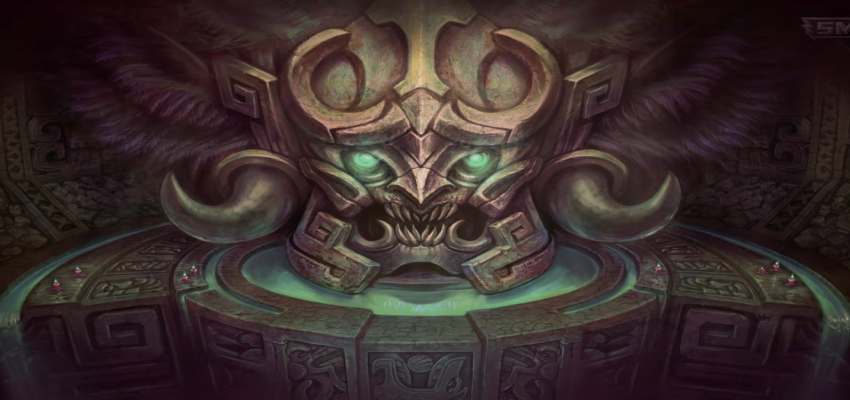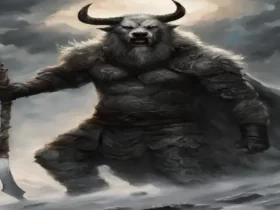The Maya civilization was an ancient civilization that lived in Central America and Mexico from 2000 BC to the 16th century AD. The Maya people believed in a complex pantheon of gods and goddesses, each with their own unique domains and responsibilities. Ah Puch was considered one of the most powerful of these gods and was associated with death, decay and the underworld.
1Ah Puch Is The Scariest God Related With Disaster & Death

Ah Puch is a god of death in Mayan mythology, who is associated with darkness, disaster, and death. However, he also represents new beginnings and is linked to the realm of childbirth. The Quiche Maya saw Ah Puch as the ruler of Metnal, the underworld, while the Yucatec Maya considered him one of the lords of Xibaba, which translates to “the place of fear” in the underworld.
2From Cum Hau To Hun Ahau, He Got Several Names
In Mayan mythology, Ah Puch has several other names: Hun Ahau, Cizin or Kisin, Hunhau, Cum Hau, Hunahau Yum Cimil, Ah Pukuh and Lord Of Death
3Mayan Depicted Him As Skeleton While Sometimes As A Bloated Figure Yet He Reflects Terror In Every Version

In Mayan art, Ah Puch was often depicted as a figure with a skeletal or decomposed appearance. Some portrayals showed him as a skeleton with protruding ribs and a skull resembling a death’s head, while others depicted him as a bloated figure representing advanced decay.
4Mayan God Ah Puch Is Associated With Owls

Ah Puch was also sometimes associated with owls and was depicted with an owl’s head. Ah Puch was often depicted as a skeleton or with decaying flesh, reflecting his association with death and decay. He was also sometimes depicted as a wrinkled old man or as a grotesque monster with multiple heads, a symbol of the terror he could inflict. In Maya art, Ah Puch was often shown with a death’s head in his hands or on top of his head.
5A Decaying Corpse With Owl Head Is Yet His Other Dreadful Identification

Similar to his Aztec counterpart, Mictlantecuhtli, Ah Puch was often depicted wearing bells in Mayan depictions. Ah Puch prefers to appear at night and move around in a frightening manner. He typically dresses as a decaying corpse with an owl’s head. To complete his frightening appearance, he uses the eyes of the dead as decorations for his headgear.
6Ah Puch Is A Christian Counterpart Of Devil Or Lucifer
He was known as “The Stinking One” due to the root of his name meaning flatulence or stench, and was said to emit a foul odor. He was closely associated with the Christian concept of the devil, as it was believed he punished evil souls in the underworld through torture. Cizin was often depicted as the antithesis of Chap, the rain god, as while Chap was shown planting trees, Cizin was shown uprooting them. In scenes of human sacrifice, he was often depicted alongside the god of war.
7He Is Often Portrayed With Smoking A Cigarette & Wearing collar made of human eyes hanging from their nerve cords

In his guise as Yum Cimil, Ah Puch was depicted wearing a collar made of dangling eyes or empty eye sockets, and his body was covered in black spots symbolizing decomposition.
8Mayans Perform Mourning Rituals In Order To Keep Away Ah Puch From Stealing Souls

The Mayans had a greater fear of death compared to other Mesoamerican cultures. Ah Puch was perceived as a hunter who stalked individuals who were injured or ill. The Mayans engaged in intense mourning rituals, including loud wailing, after the death of loved ones in order to scare Ah Puch away and resist him from taking further souls to the underworld, Metnal.
9The Popol Vuh Is The Ancient Mayan Text That Describes The Underworld Death God

The Popol Vuh, written in the 16th century, is considered to be the oldest surviving Mayan myth in its entirety. The story features two main death gods, “One Death” and “Seven Death,” who are eventually defeated by the Hero Twins. The death gods are part of a group of were-animals and ghosts known as Wayob, which inhabit the Underworld and can intentionally cause harm while they are dreaming. The concept of were-animals is significant because they symbolize transformation and can guide souls to the underworld. The bear and the wolf are two such animals. The two death gods and the Hero Twins can be seen as two aspects of the same deity.
10Not Only Death, But Ah Puch Is Also A God Of New Life, Birth & Regeneration
As previously mentioned, Ah Puch is the deity of death, darkness, and disaster, but also symbolizes regeneration, childbirth, and new beginnings.
In this context, the significance of the ancient story of Ah Puch can be understood in the context of the Popol Vuh. Ah Puch was regarded as the most feared god of death and was said to bring darkness and disaster. The Mayans would mourn silently during the day and create a loud commotion at night to scare Ah Puch away. The Spanish conquerors described him as wearing bells, which he rang as he approached. It’s possible that there was a misunderstanding or a deliberate attempt to distort the information by the Christian conquerors.
In other cultures, such as bear festivals, bells are used to drive away death and evil spirits, much like the Mayans’ ritual of screaming and wailing. This god is also associated with the moon, which has a strong influence on water and therefore life. The story therefore has shamanistic elements, with a character who can bring both life and death, serving as a psychopomp carrying souls to the afterlife and bringing new ones into the world.
Ah Puch, a well-established god of death, was known by many unpleasant names across Mesoamerica. One of his more benign titles is “The Flatulent One,” which is not a topic worth delving into further. He is infamous for his bad odor.
Despite his fearsome reputation, Ah Puch was not entirely malevolent. He was also seen as a symbol of transformation and renewal, as death was necessary for new life to emerge. The Maya believed that Ah Puch played a crucial role in the cycle of life, death, and rebirth, and that he helped to ensure the continuity of the universe. The fear and reverence that the Maya people held for Ah Puch speaks to the importance of death and the afterlife in their culture and religion.
11Ah Puch Decides The Fate Of Any Soul Brought To The Underworld

In Maya religion, death was not seen as an end but as a transition from one form of existence to another. The Maya believed that the soul of the deceased would journey to the underworld, where Ah Puch ruled over the dead. The afterlife was a place of darkness and cold, where the soul would be judged and punished for its actions in life. In order to enter the underworld, the soul was required to face various trials and obstacles, and it was said that Ah Puch would decide the fate of the soul based on how it had lived its life.
Ah Puch’s actions when targeting a victim are too horrifying to describe. The only way to avoid his attention is to make loud, frightening noises. If you can howl, shriek, moan, or scream convincingly, Ah Puch will think that you are already being taken care of by some of his lesser demons and will move on with a bitter smile after sighing “Ah…”.
12Screech Owls Are The Messenger Of Death God

However, Ah Puch, who is the Lord of Death and the god associated with the number ten, will ultimately catch up with you. He employs Muan, a malevolent bird (screech-owl) that delivers bad news, as his messenger. The belief that when an owl hoots, someone nearby will die still persists today. If you hear an owl’s call, take a deep breath and patiently count to ten.
13He Is Associated With Misfortune & Disasters
Ah Puch was also associated with disaster and misfortune. The Maya believed that natural disasters, such as earthquakes, hurricanes, and droughts, were the result of Ah Puch’s anger or dissatisfaction. To appease the god and prevent him from causing harm, the Maya offered sacrifices and made offerings to him, such as food, flowers, incense, and precious objects. These offerings were made at temples dedicated to Ah Puch or at his statue, which was usually located at the entrance of the underworld.





